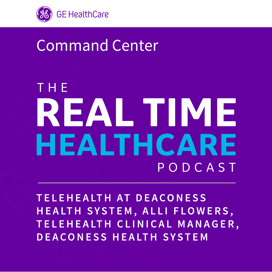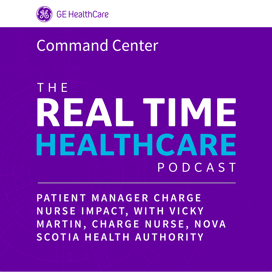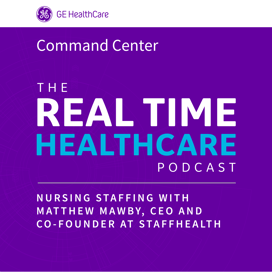#30 - Dr. Jessica Schlicher, Physician on Duty Program at Franciscan Health
Mar 2 · 13:55 min
In this Episode:
In this podcast Jeff Terry, GE HealthCare, is joined by Dr. Jessica Schlicher, who is a family medicine physician, and the Medical Director of Mission Control and of Virtual Hospital at Virginia Mason Franciscan Health. They'll discuss how the health system has tailored the Mission Control program to their needs, the tiles they utilize and the impact it has had on their organization.
Jeff Terry:
Hello and welcome. I'm Jeff Terry, very happy to be joined today by Dr. Schlicher. Dr. Jessica Schlicher, who is a family medicine physician, and of course the Medical Director of Mission Control and of Virtual Hospital at Virginia Mason Franciscan Health. Hi, Dr. Schlicher.
Dr. Jessica Schlicher:
Hello. Good to see you.
Jeff Terry:
Wonderful. Hey, so first question, you created the physician on duty program at your Mission Control, which by the way, quite a few other programs have benchmarked when they're creating their own. So could you describe for the audience that program and how it works and how you measure it?
Dr. Jessica Schlicher:
Sure. We have a team of 12 practicing clinicians, frontline leaders who work as physicians on duty, and it took about a year to convince them to come and help steer the ship here in Mission Control. Essentially, they make the health system's capacity plan for the day, and then their interventions throughout the day have to do with facilitating the prevention of lost cases, creating strategic beds, like when we're about to lose a patient, figuring out how to get downgrades and move patients and how to safely care for all those patients.
Dr. Jessica Schlicher:
And then they do quite a few critical patient safety interventions. They work to make sure that anyone coming into our tertiary facility really needs to be there and problem solve when they don't. They actually record all of those interventions and then we go back and audit them pretty rigorously, and GE's helped with that a lot. So we're pretty serious about being sure that the program pays for itself and really keeps practicing physician leaders at the front of the Mission Control.
Jeff Terry:
Is it fair to say that in that work where they're looking for beds to flip or safety, that the GE Tiles help them spot those interventions? Is that fair to say?
Dr. Jessica Schlicher:
Yeah. I think the Tiles help us to see... You could say, well, overall, our health system is overwhelmed. That's not helpful, right? And there's no real way to quickly see within our EMR, across our 11 hospitals, what you could do right now to actually better serve your whole community. So the physicians on duty will say, "Hey, we need ICU capacity at one specific hospital." And they'll make sure that they create that so that not only for the next patient, but looking ahead, they can make sure that we have for the patient we haven't met yet kind of thing.
Jeff Terry:
And you mentioned there's 12 physicians in that group. What type of physicians are they?
Dr. Jessica Schlicher:
We have five emergency medicine physicians, five hospitalists, the Chief of our Cardiovascular Service Line and our Chief of Surgery. And they work one each day in Mission Control. And it's an interesting group, when they first come into Mission Control, usually their reaction once they see the Tiles and see the status of the system is, "Oh my gosh, I had no idea." So we're also taking our very best clinical leaders and making them understand the operational language, which makes them even more effective.
Jeff Terry:
Which is brilliant. And they're a super powerful network. You share with me anecdotes of how they're able just to make things happen because they have that big picture perspective, because they have the tools and because of the network.
Dr. Jessica Schlicher:
Yeah, the most important thing they have is the clinical respect of their peers and they're highly trusted, right? So they can call one of their colleagues and ask them to do something that probably nobody else could ask them to do, just by saying, "Look, I need you to trust me. This is the right thing to do."
Jeff Terry:
That's brilliant. So you mentioned results and I'll just read them for our audience quickly. Of course, in Mission Control, you've centralized functions, you have 11 Tiles live, 12th going soon. You've empowered teams, empowered the front lines. And then the measurable impact, which was recently published, 1,432 exit stage reduced, care for 142 critical care patients was expedited and 561 patients were discharged more quickly over the last 12 months. So there's significant results for sure. The next thing I want to ask you is the impact for the health system and then the impact for the practicing clinicians? I've described sort of the metrics, but how would you characterize more broadly the, what does this mean for the health system?
Dr. Jessica Schlicher:
So we're an 11 hospital health system. We have 1,200 beds. It's surprisingly difficult though, for us to actually function as one system. Each hospital has their own culture and almost even their own language. And we really needed a way for our health system to make the right decisions in these unprecedented times where demand is extremely high and staffing is very tight. How do we make the right decision for our community and for our health system in terms of taking care of all of those patients? And that's really been made possible through Mission Control and visible through the Tiles. So we're really grateful for that.
Dr. Jessica Schlicher:
I think for the clinician, it means that there's a practicing doctor leading the health system every day. It means there's somebody who's one cell phone call away from understanding what you're facing. So when a patient is at risk or you can't get what you need, you can directly call someone who has at their fingertips all of the teams of Mission Control. Somebody who can turn around and get you an ambulance, or look to their left and get you a transfer. Look to their right, I'm just looking out over our bullpen now, they can look there and say to our tertiary site, "Look, this doc isn't getting traction, but this patient has got to come." So they have an ally who is at the very front line and I think it helps.
Dr. Jessica Schlicher:
The other piece for the clinician is you have somebody who can see everything. So one of the stories that I like the most is one of our ER physicians, one of our directors, was trolling through the ER patients and he found one at our community site who needed a neurosurgeon, which was not available at that site. The doc was able to just by turning to his right and his left in Mission Control, get an ambulance, get the bed, get the neurosurgeon on the phone and called his colleague, fellow director in the ED, and said, "Hey, you haven't seen this patient yet, but they need a neurosurgeon and there's an ambulance coming." Right? So that's what we're really working towards, right?
Jeff Terry:
So saw the problem before the local team did, solved the problem, and then contacted the local ED to say, "You had a problem that you're unaware of, we've already helped to resolve it for you." That's terrific.
Dr. Jessica Schlicher:
And the reason that's possible is because those doctors trust each other. Right? They trust their clinical judgment, they trust each other to do the right thing. So the only answer we got, it wasn't, "Oh, you're stepping on my toes." It was like, "Oh, thank God. Thank you."
Jeff Terry:
That's brilliant. And one other anecdote, could you share a bit about, you have clinical expediters in your Mission Control, and I think the way you use your clinical expediters has been really impactful. I know we've been impressed and benchmarked it for others. Could you describe, just day-to-day, what do they do?
Dr. Jessica Schlicher:
Sure. So they do a lot and they've taught me a lot. We actually have a team huddle every day here in which every team member talks about what their most critical need is. So each hospital patient placement nurse often will say, "Well, I've got five surgeries for this unit, but I've only got one bed." So the expediter steps in to say, "Okay, that has to be fixed." And they figure out how to fix it. Sometimes they'll call the PT on that floor who maybe has 30 patients and doesn't know who should be first. And they'll ask them and sort of negotiate that, "Hey, could you please put these two at the top? Because in two hours when these patients come out of the OR, they're going to need these rooms."
Dr. Jessica Schlicher:
And so health systems are aware that they're over capacity, right? And that everybody's stretched beyond what they can perhaps do in one day. But the expediter is able to look surgically at what change could we make that would allow us to create the capacity that we need right now, or the capacity we know we're going to need in very short order.
Jeff Terry:
And I've sat with him while he does it. You use the border summary Tile to see where's the pressure building, then discharge, planning and care progression to say, "What can I do to relieve the pressure in the hottest spots in the system?" All the time, doing that actively, which is... I don't know, really impressive.
Dr. Jessica Schlicher:
Yeah, they go through all of those alerts several times a day. I don't know how they do it.
Jeff Terry:
So perfect. So another thing I know our audience is interested about is Virtual Hospital. Of course, you are the Medical Director for Mission Control and Virtual Hospital, which in your health system are adjacencies. So could you quickly describe what's in each of those and how they work together?
Dr. Jessica Schlicher:
Sure. So Mission Control has all of our bed placement for all of our hospitals, the clinical expediter, which is very aligned with that team. We have ambulance dispatch, we have our physician on duty program, transfer center. We have a number of schedulers and then we have nurse staffing for all of our hospitals. The Virtual Hospital has the clinical services around telemetry, heart monitoring, virtual companion, or one-to-one sitters, virtual ICU, virtual hospitalist service that covers five of our hospitalists with one team at night. Our consulting nurse service, which is in a couple of states, and then our contact center, which does all the call handling and calling codes and things like that for all of our hospitals and clinics.
Dr. Jessica Schlicher:
We also recently added virtual palliative care where we have a palliative medicine physician who will provide consults throughout the health system. So I'd say Mission Control is air traffic control, really, and then very well integrated with Virtual Hospital. So an example of that might be, we might be down several CNAs at one hospital, or we might need to redeploy them for something else, for one-to-one care. And so the Virtual Hospital could perhaps open up another virtual monitoring station so that the patients can be cared for at a six-to-one ratio rather than a one-to-one, something like that.
Jeff Terry:
So Mission Control is coordinating care holistically and the Virtual Hospital is another key care delivery asset, like the hospitals, like the... That makes sense. And by the way, one thing I know we've talked about before as well is they have shared governance, which I think is important that those two important resources stay in alignment by virtue of shared governance. Is that right?
Dr. Jessica Schlicher:
Yeah, we have a shared Mission Control and Virtual Hospital Board, and also all of our leadership is shared. So our Division Director and myself and our COO are the same. So that works well because if we're asking something of Virtual Hospital, we know that hopefully it's reasonable and we're going to get it on both sides.
Jeff Terry:
Perfect. So next question is that we've talked a little bit about the Tiles, but could you just share for the audience, sort of from your personal perspective, your favorite Tiles?
Dr. Jessica Schlicher:
So when I walk into Mission Control in the morning, in about 30 seconds I can tell exactly what's happening across the health system. What I do is I start with borders, and so I see both patients with a bed request and patients who are long stay, like maybe they're detained, but I can see every patient who's stuck. And then I can look at our capacity snapshot and I can see exactly where there's space. And usually at that point, I turn around to our patient placement nurses and say, "There's space, but do you have a plan for that?" So between those three steps, pretty much about one minute, you can understand where the problems are.
Jeff Terry:
So a ton has been accomplished, obviously it's a struggle every day, 2020, fascinating year with COVID. And of course you guys were in one of really the first US epicenter of COVID and I know Mission Control was important in responding to that. But where does it go next? So what's your vision for where you take this thing?
Dr. Jessica Schlicher:
Well, I've got big dreams. How long do you have? Just kidding. Our next Tile is our procedural and surgical growth Tile. And the reason for that is that one of the things that I think probably all health systems struggle with is the need to fulfill the surgical and procedural needs of the community within the capacity that's present in the hospital seven days a week, right? And to sort of smooth that and to manage that intelligently. So we need to appropriately grow our surgical and procedural volume. So we really need better visibility about where we have space, not just in the surgery schedule, but where are we going to have space in the hospital?
Dr. Jessica Schlicher:
And even though it seems like that should be straightforward, it's really not. It's really hard to see that and to anticipate what the right decision is in terms of the number of add-ons you can have in a certain day, the amount of bed demand you can tolerate. And what we're finding and what we've found throughout the year, is that even with the immense demands of COVID and with staffing challenges, there's always a solution. There's always a way to figure out how to get the patient cared for. And you just have to have the right people and you have to have the right insight into what to do next.
Jeff Terry:
Well, Jessica, thank you so much for joining this and thank you for letting us work for you these last several years. We love it and long may it continue. And yeah, thanks for joining. And with that, I think I'll close the podcast.
Dr. Jessica Schlicher:
Thanks so much.
*The tiles represented do not replace the patient monitoring devices.







